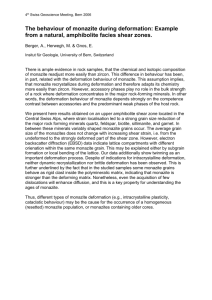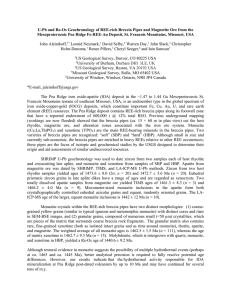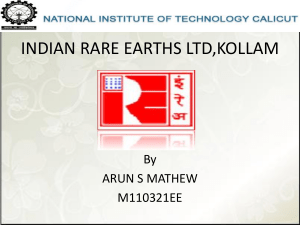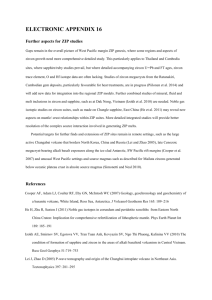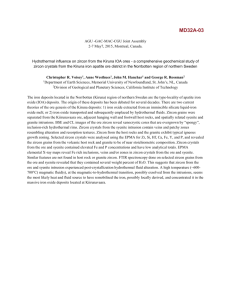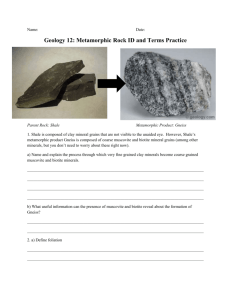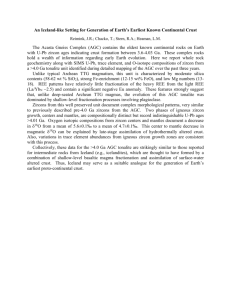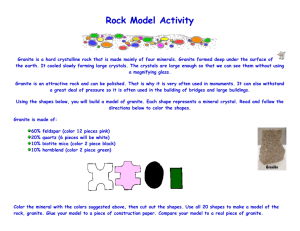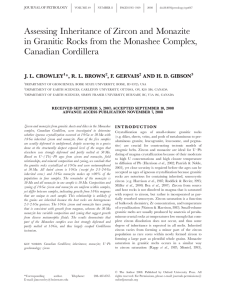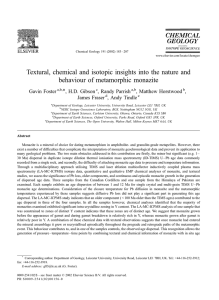Electronic Supplementary Material
advertisement
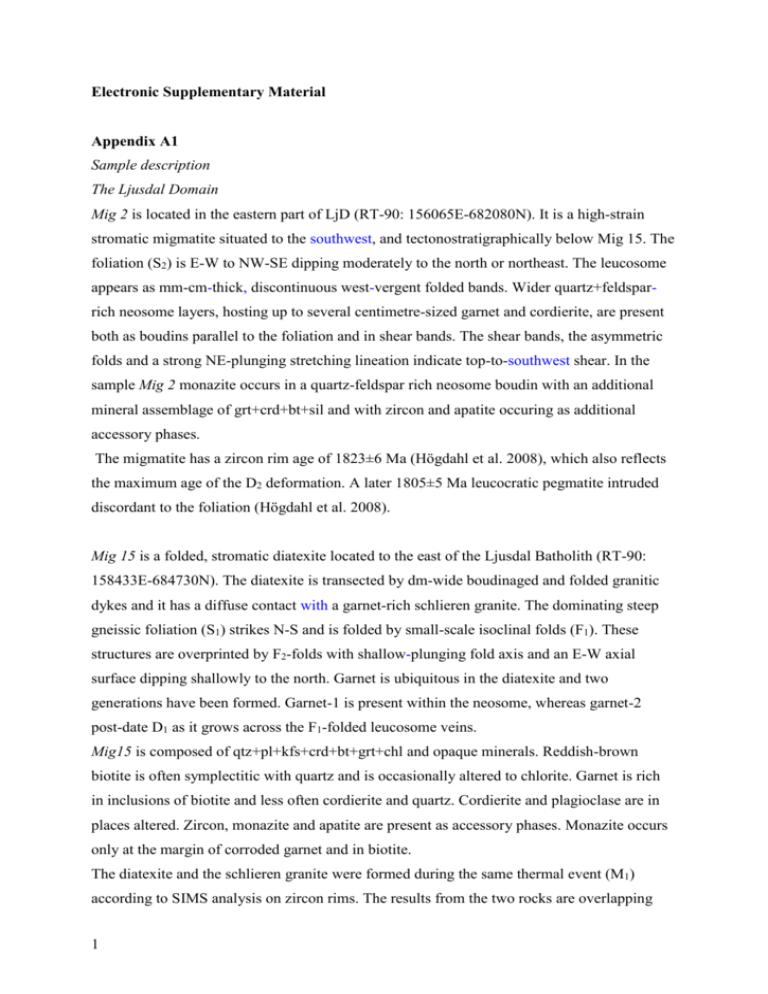
Electronic Supplementary Material Appendix A1 Sample description The Ljusdal Domain Mig 2 is located in the eastern part of LjD (RT-90: 156065E-682080N). It is a high-strain stromatic migmatite situated to the southwest, and tectonostratigraphically below Mig 15. The foliation (S2) is E-W to NW-SE dipping moderately to the north or northeast. The leucosome appears as mm-cm-thick, discontinuous west-vergent folded bands. Wider quartz+feldsparrich neosome layers, hosting up to several centimetre-sized garnet and cordierite, are present both as boudins parallel to the foliation and in shear bands. The shear bands, the asymmetric folds and a strong NE-plunging stretching lineation indicate top-to-southwest shear. In the sample Mig 2 monazite occurs in a quartz-feldspar rich neosome boudin with an additional mineral assemblage of grt+crd+bt+sil and with zircon and apatite occuring as additional accessory phases. The migmatite has a zircon rim age of 1823±6 Ma (Högdahl et al. 2008), which also reflects the maximum age of the D2 deformation. A later 1805±5 Ma leucocratic pegmatite intruded discordant to the foliation (Högdahl et al. 2008). Mig 15 is a folded, stromatic diatexite located to the east of the Ljusdal Batholith (RT-90: 158433E-684730N). The diatexite is transected by dm-wide boudinaged and folded granitic dykes and it has a diffuse contact with a garnet-rich schlieren granite. The dominating steep gneissic foliation (S1) strikes N-S and is folded by small-scale isoclinal folds (F1). These structures are overprinted by F2-folds with shallow-plunging fold axis and an E-W axial surface dipping shallowly to the north. Garnet is ubiquitous in the diatexite and two generations have been formed. Garnet-1 is present within the neosome, whereas garnet-2 post-date D1 as it grows across the F1-folded leucosome veins. Mig15 is composed of qtz+pl+kfs+crd+bt+grt+chl and opaque minerals. Reddish-brown biotite is often symplectitic with quartz and is occasionally altered to chlorite. Garnet is rich in inclusions of biotite and less often cordierite and quartz. Cordierite and plagioclase are in places altered. Zircon, monazite and apatite are present as accessory phases. Monazite occurs only at the margin of corroded garnet and in biotite. The diatexite and the schlieren granite were formed during the same thermal event (M1) according to SIMS analysis on zircon rims. The results from the two rocks are overlapping 1 and gave a combined age of 1859±3 Ma (Högdahl et al. 2008). A later heat pulse (M2) is indicated by the presence of garnet-2. The Granite and Diatexite Belt Mig 9 is from the eastern part of the Granite and Diatexite Belt (RT-90: 155560E-691848N). It is a coarse- to medium-grained, mesocratic diatexite with a granodioritic composition. It hosts scattered K-feldspar crystals, which are mostly 1-2 cm in size. The diatexite has a WNW-ESE gneissic D1 foliation dipping moderately to the north. Biotiteschlieren, palaeo- and melanosome fragments, and decimetre wide leucocratic patches with diffuse contacts to the dominating mesocratic diatexite occur parallel to the foliation. Subhorizontal stretching lineation within the palaeosome and steeply-dipping, leucosome filled NE-SW-trending shear bands indicate sinistral shear during the formation of the migmatite. The gneissic foliation is affected by later, steeply-southeast-dipping D3 sinistral shear zones formed under subsolidus conditions. The mineral assemblage of the matrix in Mig 9 consists of qtz+kfs+pl+chl+bt+grt+ms and opaque minerals. The K-feldspar is well-preserved, but plagioclase is strongly saussuritised, most of the biotite is altered to chlorite and the cordierite is completely pinitised. Garnet is corroded at the margin and surrounded by a replacement assemblage composed of mainly bt(chl)+ms+qtz. Garnet is also altered internally along cracks. Zircon, monazite and apatite are common accessory phases. SIMS analysis on zircon rims yield a concordant weighted average 207Pb/206Pb age of 1861±2 Ma (Högdahl et al. 2008). Mig 10 is from the easternmost part of the Granite and Diatexite Belt (RT-90: 158628E690635N). It is a medium-grained garnet-biotite-bearing leucogranite with a pronounced E-W foliation dipping moderately to the north. K-feldspar is present both in the matrix and as slightly larger euhedral crystals. Plagioclase is saussiritised to variable degrees and biotite is to a large extent altered to chlorite and rich in opaque inclusions. Zircon, monazite and apatite are common accessory phases. Monazite is hosted in biotite that wraps around garnet porphyroclasts. Geochronology on multigrain zircon fractions by U-Pb TIMS gave an upper intercept age of 2030±6 Ma (Welin et al. 1993), which they interpreted to reflect timing of emplacement. However, the zircons are brownish, cloudy, partly metamict and large, inherited cores are common. SIMS analysis on zircon rims did not give a conclusive result due to the partly 2 metamict state of the crystals and consequently severe Pb-loss, but it indicates a significantly younger age of about 1.85 Ga (Högdahl et al. 2008). TOB050126. This sample is a garnet-bearing, leucocratic schlieren granite from the easternmost part of the Granite and Diatexite Belt (RT-90: 1589172E-6904569N). Grain size is variable and the distribution of mafic minerals is heterogeneous. In more strongly deformed parts, the foliation is ENE-WSW, dipping moderately to the north. Biotite occurs both in the matrix and as rather coarse-grained, centimetre-long schlieren. Coarse-grained biotite-1 in the schlieren forms symplectites with quartz, while biotite-2 is formed due to garnet retrogression and is rich in monazite. Partly retrogressed garnet is also present in diffuse quartz+feldspar veins and patches. Cordierite is common in the matrix and appears both as well-preserved and pinitised crystals. The latter, typically together with sillimanite and fibrolite, is found in altered biotite-1. Accessory phases are zrn+mnz+ms+ap and opaque minerals. 87034 and PDN050104 (RT-90: 157767E-691246N). These two samples are from the same leucogranite intrusion emplaced in a metatectic greywacke. It is a fine- to medium-grained, Kfeldspar-porphyric, garnet-bearing, two-mica granite with biotite much more abundant than muscovite, which has traditionally been referred to as a Härnö granite (e.g. Magnusson 1946). It is rather heterogeneous and garnet is more frequent in biotite schlieren and in decimetrewide irregular quartz+feldspar veins. Pegmatite dykes are common and both the granite and the pegmatites locally show a strong steeply-dipping NNW-SSE foliation. The main assemblage in the granite is kfs+qtz+pl+bt+grt+ms whereas zircon, monazite, apatite, and subordinate sillimanite constitute the accessory phases. Sample 87034 has previously been dated at 1822±5 Ma by U-Pb TIMS analysis on multigrain monazite fractions (Claesson and Lundqvist 1995). Appendix A2 SIMS analyses The SIMS analyses were performed on a Cameca 1270 at the Nordsim Laboratory at the Swedish Museum of Natural History, Stockholm. The monazite was mounted in epoxy and polished to expose the interior parts of the crystals. Before SIMS analyses the crystals were imaged by BSE and thereafter coated with 25 nm gold. The monazite analyses were performed at a primary beam current of between 5-10 nA with a voltage of 23 kV producing an ellipsoid spot with a size of c. 25x15 m. The mass peaks 140CePO2, 203.25, 3 232 Th143Nd16O2++, 141PrPO2, 204Pb, 206Pb, 207Pb, 208Pb, Th, U, UO, ThO2 and UO2 were measured at a peak-skipping mode. A Neoarchaean monazite (C-83-32) with an age of 2685±2 Ma (Corfu 1988) was used as a standard and measured repeatedly during the analyses. Zircon crystals from sample TOB050126 were mounted in epoxy together with chips of the 1065 Ma 91500 reference zircon (Wiedenbeck et al. 1995), polished and imaged by BSE. The SIMS analysis was performed under the same conditions as the monazite, but using a small aperture producing an analytical spot of 15x15 m, measuring the following masses: 90Zr216O (196), 204Pb (204), background (204.2), 206Pb (206), 207Pb (207), 208Pb (208), 235U (235), 238U (238), 232Th16O (248), 238U16O2 (270). Detailed analytical and calibration procedures are given by Whitehouse et al. (1999), Whitehouse and Kamber (2005) and Kirkland et al. (2009). Corrected isotope values were calculated using present-day common Pb composition (Stacey and Kramers 1975) and measured 204Pb, and decay constants applied were those recommended by Steiger and Jäger (1977). Isoplot/Ex ver. 3.00 (Ludwig 2003) was used for constructing the concordia diagrams. The calculated ages are the weighted means of the 207 Pb/206Pb and 238U/206Pb concordant pair (Ludwig 2003), the MSWD value is combined equivalence and concordance and the error is given in 2 a priori. Isotope data, U,Th and Pb concentrations for monazite are given in Table A1 and for zircon ín Table A3. The chemical composition of the monazite is given in Table A2. Appendix A3 Electron Microprobe analysis (EMP) X-ray maps were produced showing the relative distribution of Y, Th, U and Pb on monazite from two samples (Mig 15 and TOB050126). The X-ray maps and additional chemical analyses close to the SIMS spots on all dated monazite were collected by a Cameca SX-50 EMP in the National Microprobe Laboratory at the Department of Earth Sciences, Uppsala University, Sweden. An accelerating voltage of 20 kV and a beam current of 50 nA were used. One of the samples (Mig 15) was additionally selected for EMP U-Th total-Pb dating as some of the monazite displays a heterogeneous BSE pattern with domains smaller than the analytical spot produced by SIMS. EMP dating and chemical characterisation on the dated domains was preformed by a Cameca SX-100 at the Department of Electron Microanalysis at the Dionýz Štúr 4 State Geological Institute in Bratislava, Slovak Republic. A beam current of 180 nA and 15kV accelerating voltage were used with a beam diameter of 3 µm. The counting time for Si, Al, Ca, P and As was 20 seconds, for REE 25 seconds, for Th and Y 30 seconds, for U 65 seconds and for Pb 150 seconds, respectively. The following standards, natural or synthetic, were used for calibration: Si-wollastonite, Al-Al2O3, Ca-wollastonite, Pb-PbS, Th-ThO2, UUO2, and P-apatite, As-GaAs2, S-pyrite, Fe-fayalite, Sr-SrTiO3, REE and Y-phosphates. Si, Al, As were measured with the use of TAP crystal; Ca, Pb, U, Th, Y, and P were measured with the use of LPET crystal; and REE with the use of LLIF crystal. Kα lines were measured for determination of Si, Al, Ca, P, Fe, Sr, S abundances; Lα lines for La, Ce, Gd, Tb, Tm, Yb, Y, and As; Lβ lines for Pr, Nd, Sm, Eu, Dy, Ho, Er, and Lu; Mα lines for Pb and Th, and the Mβ line was measured for determination of U abundance. Interference of Pb M with Y L2,3, Th M1, Th M2 and UM with ThM, ThM3-N4, ThM5-P3 were corrected by empirically-derived coefficients (Åmli and Griffin 1975; Pyle et al. 2002). PAP corrections were applied throughout. Age calculations for each compositional domain, identified by the X-ray maps, were based on the method of Montel et al. (1996). Apparent ages were calculated for each spot analysis and presented on histograms. The individually spot data were subsequently processed together and a weighted mean age was calculated for each compositional domain. The age calculation was performed using Microsoft Excel Visual Basic program DAMON (Konečný et al. 2004) that reads the data, calculates apparent ages and resulting weighted average ages, and constructs histograms and pseudo-isochrones. The results from the EMP U-Th total-Pb dating are listed in Table A4. References in appendices Åmli R, Griffin W (1975) Microprobe analysis of REE minerals using empirical correction factors. Am Min 60:599-606 Claesson S, Lundqvist Th (1995) Origins and ages of Proterozoic granitoids in the Bothnian Basin, central Sweden; isotopic and geochemical constraints. Lithos 36:115-140 Corfu F (1988) Differential response of U-Pb systems in coexisting accessory mineral, Winnipeg River Subprovince, Canadian Shield: implications for Archean crustal growth and stabilization. Contrib Mineral Petrol 98:312-325. doi: 10.1007/BF00375182 5 Högdahl K, Sjöström H, Andersson UB, Ahl M (2008) Continental margin magmatism and migmatisation in the west-central Fennoscandian Shield. Lithos 102:435-459. doi:10.1016/j.lithos.2007.07.019 Kirkland CL, Whitehouse MJ, Slagstad T (2009) Fluid-assisted zircon and monazite growth within a shear zone; a case study from Finmark, Arctic Norway. Contrib Mineral Petrol 158:637-657. Doi 10.1007/s00410-009-0401x Konečný P, Siman P, Holicky I, Janak M, Kollarova V (2004) Metodika datovania monazitu pomocou elektronoveho mikroanalyzatora [Method of monazite dating by means of the electron micrprobe. In Slovak with English summary]. Mineralia Slovaca 36:225-235 Ludwig KR (2003) Isoplot 3.00; A geochronological toolkit for Microsoft Excel. Berkely Geochronological Center Publication No. 4 Magnusson NH (1946) Den svenska urbergsforskningen under de senaste tjugofem åren (in Swedish). GFF Trans Geol Soc Stock 68:171-200 Montel JM, Foret S, Veschambre M, Nicollet Ch, Provost A (1996) Electron microprobe dating of monazite. Chem Geol 131:37-53 Pyle JM, Spear F, Wark DA (2002) Electron microprobe analysis of REE in apatite, monazite and xenotime: protocols and pitfalls. In: Kohn MJ, Rakovan J, Hughes JM (Eds), Phosphates - geochemical, geobiological, and materials importance, 337-362. Reviews in Mineralogy and Geochemistry 48, Mineralogical Society of America Steiger RH, Jäger E (1977) Subcommission of geochronology: Convention on the use of decay constants in geoand cosmochronology. Earth Planet Sci Lett 36:359-362 Welin E, Christiansson K, Kähr AM (1993) Isotopic investigations of metasedimentary and igneous rocks in the Paleoproterozoic Bothnian Basin, central Sweden. GFF Trans Geol Soc Stock 115:285-296 Wiedenbeck M, Allé P, Corfu F, Griffin WL, Meier M, Oberli F, von Quadt A, Roddick JC, Spiegel W (1995) Three natural zircon standards for U-Th-Pb, Lu-Hf, trace element and REE analysis. Geostandards Newsletter 19:1-23. Whitehouse MJ, Kamber BS (2005) Assigning dates to thin gneissic veins in high-grade metamorphic terranes: A cautionary tale from Akilia, southwest Greenland. J Petr 46:291-318 Whitehouse MJ, Kamber BS, Moorbath S (1999) Age significance of U-Th-Pb zircon data from early Archaean rocks of west Greenland - a reassessment based on combined ion-microprobe and imaging studies. Chem Geol 160:201-224 6 7
